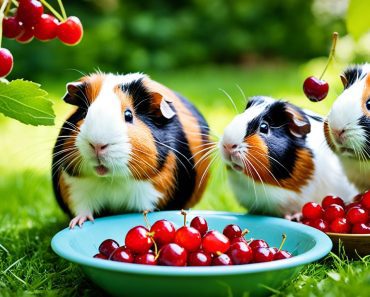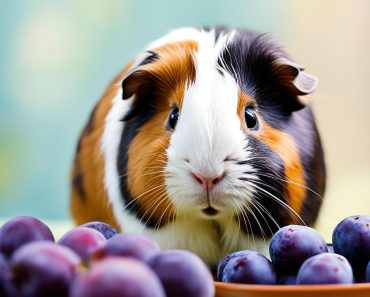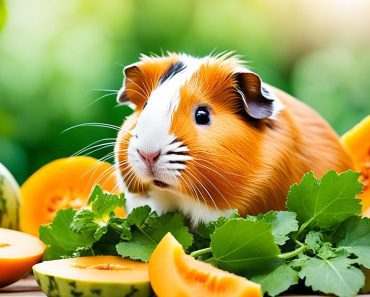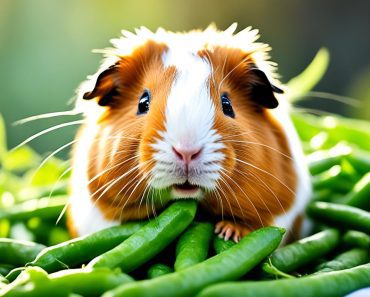Hey there, fellow guinea pig enthusiasts! If you’re wondering whether or not it’s safe to feed your adorable little furballs some spinach leaves, you’ve come to the right place. As an avid guinea pig owner myself, I understand the importance of providing our fluffy friends with a healthy and balanced diet.
So, can guinea pigs eat spinach leaves? The answer is yes! However, it’s crucial to exercise caution and moderation when it comes to incorporating spinach into their diet. While spinach contains essential nutrients like Vitamin A, Vitamin C, and calcium – all of which are beneficial for our guinea pigs’ overall health – it also contains high levels of calcium oxalates, which can potentially contribute to urinary tract problems.
Maintaining a well-rounded diet for our beloved guinea pigs is essential. While spinach can be a nutritious addition, it should not be the sole source of their nutrition. It’s important to include a variety of leafy greens, vegetables, and fruits to provide well-rounded and balanced meals.
Can Guinea Pigs Eat Spinach Leaves? Yes, but only given in moderation.
- Guinea pigs can eat spinach, but it should be given in limited amounts.
- Spinach contains essential nutrients like Vitamin A, Vitamin C, and calcium.
- However, spinach also contains high levels of calcium oxalates, which can contribute to urinary tract problems.
- Maintain a balanced diet for guinea pigs and incorporate a variety of leafy greens, vegetables, and fruits.
- Consult with a veterinarian for specific dietary recommendations for your guinea pigs.
The Benefits of Spinach for Guinea Pigs
When it comes to guinea pig nutrition, spinach can be a valuable addition to their diet. This leafy green vegetable offers several benefits that contribute to the overall health and well-being of guinea pigs. Let’s explore the advantages of feeding spinach to our furry friends.
Nutritional Value
Spinach is packed with essential nutrients that support guinea pig health. It is a rich source of Vitamin A, which plays a crucial role in maintaining optimal eyesight. Additionally, spinach contains Vitamin C, a vital nutrient that guinea pigs require to prevent scurvy, a condition characterized by weakened immune system and joint pain. Including spinach in their diet can help guinea pigs meet their daily Vitamin C requirements.
Furthermore, spinach provides calcium, which is essential for bone health. The presence of calcium in spinach is especially beneficial for growing guinea pigs and those recovering from injuries. However, it’s important to note that the calcium levels in spinach should be balanced with other food sources to minimize the risk of bladder stones, a common problem in guinea pigs.
Did You Know? Calcium oxalates, found in high amounts in spinach, can contribute to the formation of bladder stones in guinea pigs, so moderation is key when it comes to feeding spinach to your little pet.
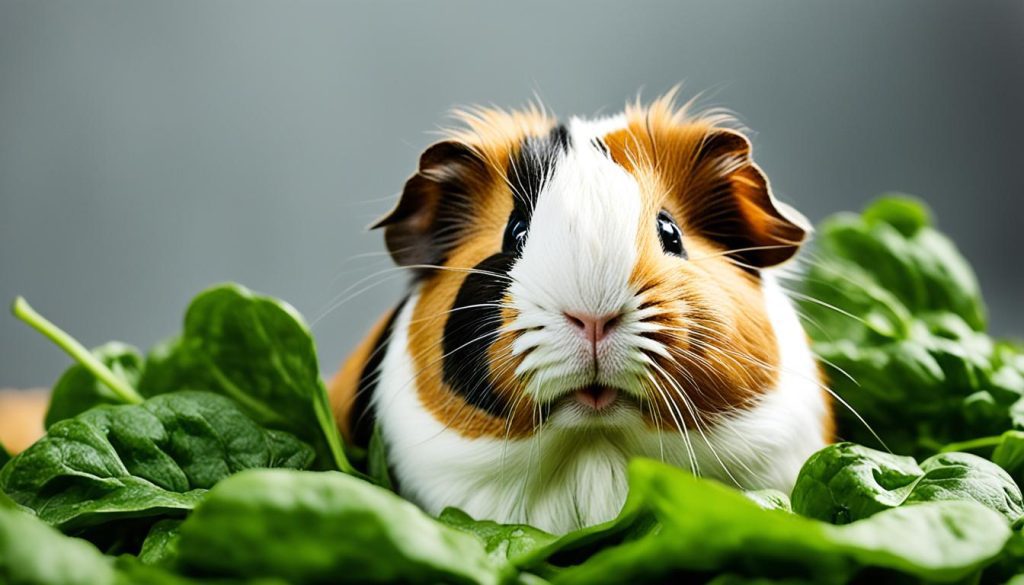
Variety in Diet
Introducing spinach into a guinea pig’s diet adds variety to their meals. While hay should form the foundation of their diet, incorporating different types of vegetables and leafy greens, including spinach, ensures that guinea pigs are exposed to a range of nutrients. This variety can prevent the development of nutrient deficiencies and keep guinea pigs satisfied and interested in their meals.
“Spinach provides guinea pigs with essential vitamins and minerals that contribute to their overall health. Just remember to offer spinach in moderation, maintaining a balanced diet for these adorable creatures.”
Serving Tips
When feeding spinach to guinea pigs, it is important to follow proper serving guidelines. Offer spinach in small portions as part of a diverse diet that includes other leafy greens, vegetables, and hay. A suitable serving size for spinach is approximately 40 grams per day, which is equivalent to about 4 leaves with stems. This amount ensures that guinea pigs receive the benefits of spinach without an excess of calcium oxalates.
In conclusion, spinach can be a valuable addition to a guinea pig’s diet, providing essential vitamins and minerals that support their health. Remember to offer spinach in moderation and alongside other nutritious foods, prioritizing a well-balanced diet for these adorable creatures.
The Potential Risks of Feeding Spinach to Guinea Pigs
While spinach can be a nutritious food for guinea pigs, it’s essential to be aware of the potential risks it poses. Spinach contains high levels of calcium oxalates, which can contribute to the formation of bladder stones in guinea pigs. These stones can lead to urinary tract issues and discomfort for your furry friend.
It’s crucial to monitor the amount of spinach given to your guinea pig and balance it with other leafy greens that have lower oxalate levels. This will help reduce the risk of bladder stone formation and ensure a healthier diet overall.
When considering leafy greens for your guinea pig’s diet, there are several other options that can provide similar nutritional benefits without the same level of risk. It’s important to offer a varied diet that includes a range of safe leafy greens to ensure your guinea pig receives a well-balanced and nutritious menu.
“It’s crucial to monitor the amount of spinach given to your guinea pig and balance it with other leafy greens that have lower oxalate levels.”
To ensure your guinea pig’s diet is well-balanced and safe, it’s always best to consult with a veterinarian who specializes in small animal care. They can provide personalized advice and recommendations based on your guinea pig’s specific needs and health status.
Common Safe Leafy Greens for Guinea Pigs:
- Romaine lettuce
- Red and green leaf lettuces
- Kale
- Cabbage
These alternatives to spinach offer a range of essential nutrients and are generally safe for guinea pigs when fed in moderation. Remember to introduce new foods gradually and monitor your pet’s digestive reactions to ensure they tolerate the changes well.
A Comparison of Oxalate Levels in Leafy Greens
| Leafy Green | Oxalate Level (mg per 100g) |
|---|---|
| Spinach | 750 |
| Romaine lettuce | 2 |
| Red leaf lettuce | 2 |
| Green leaf lettuce | 2 |
| Kale | 19 |
| Cabbage | 5 |
As you can see from the table above, spinach has significantly higher oxalate levels compared to other leafy greens, making it important to limit its consumption.
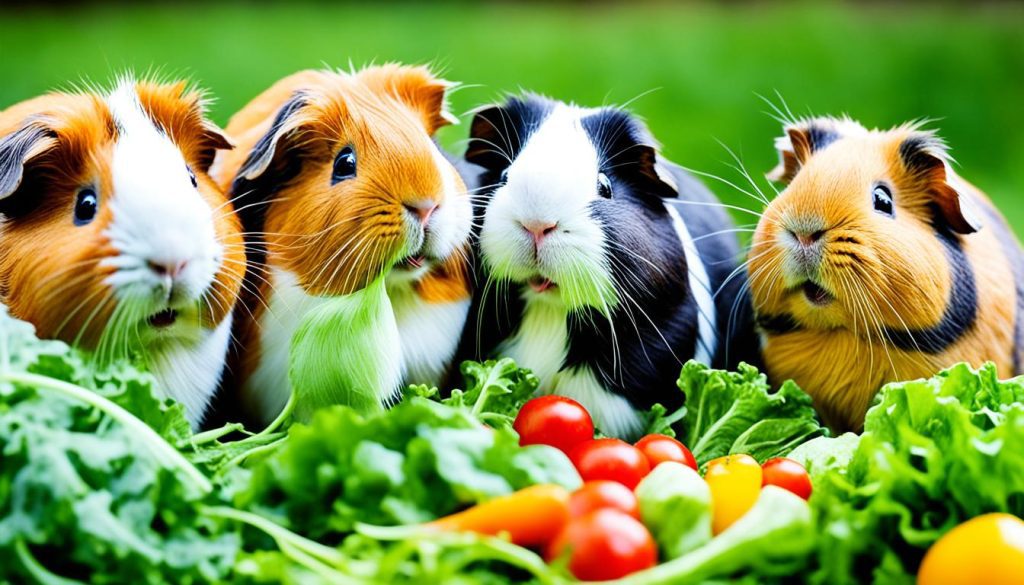
Remember, providing a well-balanced diet is key to keeping your guinea pig healthy and happy. By understanding the potential risks and opting for safer alternatives to spinach, you can ensure your furry friend enjoys a nutritious and satisfying diet.
Recommended Serving Size and Frequency
When it comes to feeding spinach to your guinea pig, moderation is key. Due to its high calcium and oxalate content, spinach should be given in small amounts as part of a diverse diet that includes other leafy greens. The ideal serving size for spinach is around 40 grams per day, which is roughly equivalent to 4 leaves with stems.
It’s important to note that while spinach provides essential nutrients, such as Vitamin A and Vitamin C, excessive consumption can lead to urinary tract issues in guinea pigs. Therefore, it’s crucial to balance the calcium to phosphorus ratio in their diet to avoid complications.
Not sure how to incorporate spinach into your guinea pig’s meals? Here’s an example of a well-rounded daily diet:
| Food | Serving Size | Frequency |
|---|---|---|
| Hay | Unlimited | Throughout the day |
| Pellets | 1/8 cup | Once a day |
| Leafy Greens (including spinach) | 40 grams | Once a day |
| Vegetables (e.g., bell peppers, carrots) | 1/8 cup | Once a day |
| Fruits (e.g., strawberries, blueberries) | Small treats | Occasionally |
By following this recommended serving size and frequency, you can ensure that your guinea pig receives a balanced diet and enjoys the nutritional benefits of spinach without risking their health.
Other Suitable Foods for Guinea Pigs
Besides spinach, guinea pigs can enjoy a variety of other vegetables and fruits. Including these options in their diet ensures a balanced nutrition that promotes their overall health and well-being.
Leafy Greens
Leafy greens are a crucial part of a guinea pig’s nutrition. They provide essential vitamins, minerals, and fiber. Here are some safe leafy greens for guinea pigs:
- Romaine lettuce
- Red and green leaf lettuces
- Kale
- Cabbage
Other Vegetables
In addition to leafy greens, guinea pigs can enjoy a variety of other vegetables. These vegetables are safe for guinea pigs and provide additional nutrients:
- Bell peppers
- Carrots
- Cucumbers
- Zucchini
Fruits
Fruits make a sweet treat for guinea pigs and can be given occasionally. They provide natural sugars and additional vitamins. Here are some fruits that guinea pigs can enjoy:
- Strawberries
- Blueberries
- Melons
It’s important to introduce new foods gradually and monitor how your guinea pig responds to them. Some guinea pigs may have individual sensitivities or preferences. Providing a diverse and balanced diet is key to keeping your guinea pig healthy and happy.
| Leafy Greens | Other Vegetables | Fruits |
|---|---|---|
| Romaine lettuce | Bell peppers | Strawberries |
| Red and green leaf lettuces | Carrots | Blueberries |
| Kale | Cucumbers | Melons |
| Cabbage | Zucchini |
Conclusion
After carefully considering the benefits and risks of feeding spinach to guinea pigs, it is clear that spinach can be included in their diet, but in moderation. Spinach contains essential nutrients like Vitamin A, Vitamin C, and calcium, which are important for guinea pig health. However, its high calcium oxalate content can lead to urinary tract problems if consumed in excess.
To ensure a well-balanced diet for your guinea pig, it is crucial to offer a variety of leafy greens, vegetables, and fruits alongside spinach. This will provide a range of nutrients and prevent over-reliance on a single food source. Aim for a diverse diet that includes leafy greens such as romaine lettuce, red and green leaf lettuces, kale, and cabbage.
Consulting with a veterinarian is strongly recommended to get specific dietary recommendations for your guinea pig. They can guide you on the ideal serving size and frequency of spinach for your pet. Remember, a healthy and happy guinea pig is the result of a carefully planned and varied diet.


